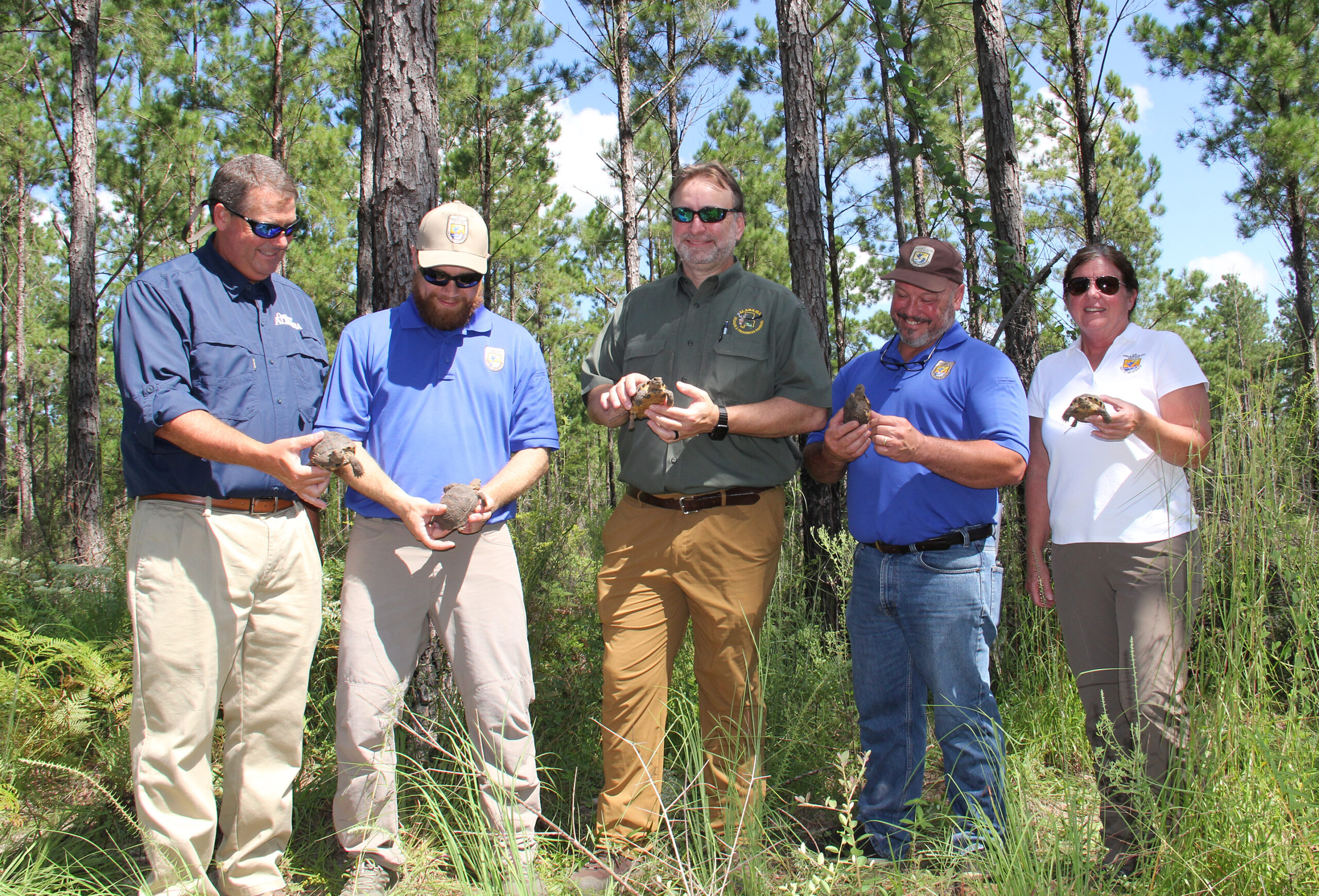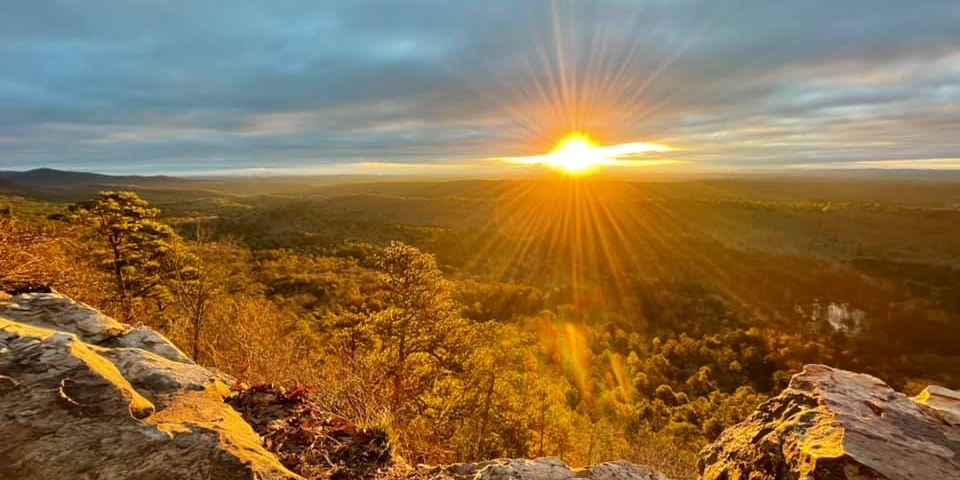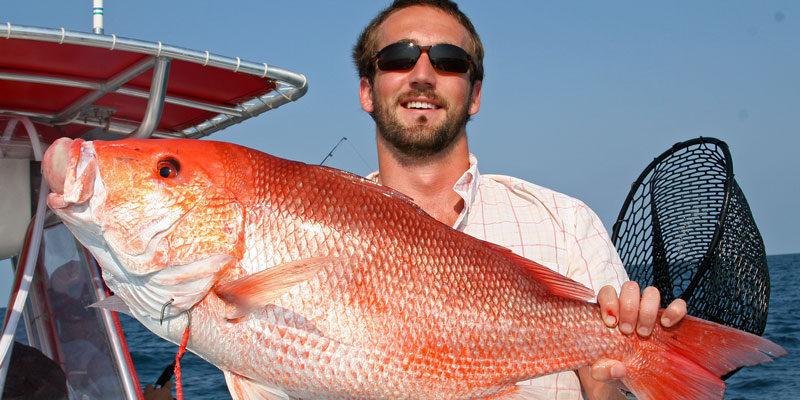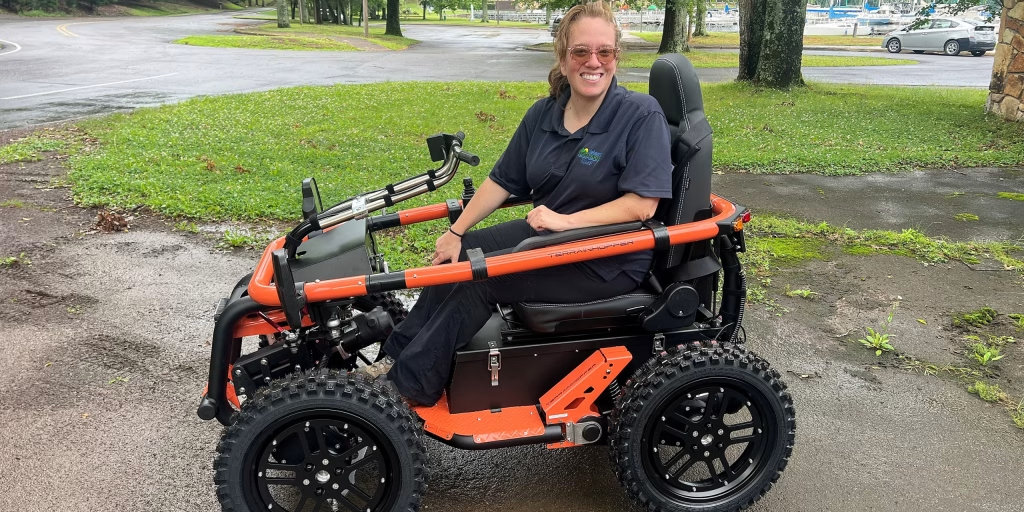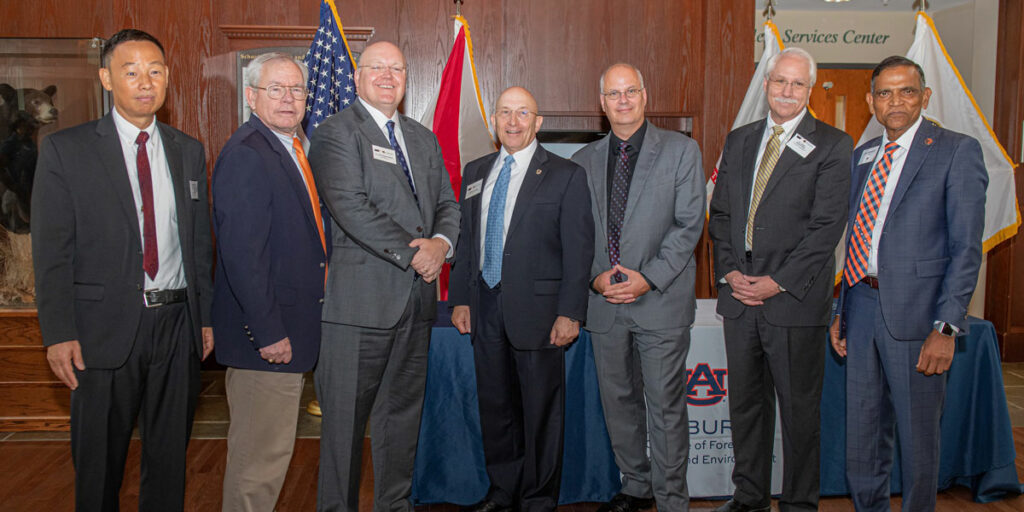Gopher tortoise conservation reached a new level recently when the Alabama Department of Conservation and Natural Resources teamed with the U.S. Fish and Wildlife Service, Eckerd College and Birmingham Zoo to release 98 young tortoises into the Geneva State Forest Wildlife Management Area in Covington County.
The gopher tortoise is considered a keystone species, which impacts about 365 species of amphibians, reptiles, birds, mammals and invertebrates in the sandy-soil habitat.
Jeff Goessling, who is on the forefront of the tortoise conservation efforts, said the gopher tortoise burrow is the key to the species.
“This is an important animal for a lot of species,” Goessling, an assistant professor at Eckerd College, said. “It’s the burrow that has that function. They spend about 98 percent of their life in that burrow.”
The Geneva State Forest WMA gopher tortoise project, led by Goessling, is funded through the Cooperative Endangered Species Conservation Fund with USFWS, which provides funds for conservation efforts for listed, at-risk and endangered species on non-federal land.
Amy Silvano, assistant chief of Wildlife for the Wildlife and Freshwater Fisheries Division, thanked Eckerd College and the Birmingham Zoo for their contributions to the project.
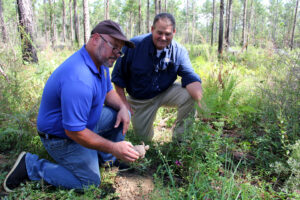
“Both of these entities have stepped up to do the research and raise the headstart (hatchlings) tortoises that we released,” Silvano said. “And I also want to thank Dr. Craig Guyer for all his work on this project and his continued dedication towards gopher tortoise conservation in Alabama.”
WFF staff, Eckerd College representatives and Birmingham Zoo staff constructed starter burrows to prepare for the release.
Conservation Commissioner Chris Blankenship, WFF Director Chuck Sykes, USFWS Southeast Region Director Leopoldo “Leo” Miranda-Castro, USFWS Alabama section coordinator Shannon Holbrook, and John Tupy, gopher tortoise lead for the range out of the USFWS Hattiesburg office, participated in the release.
Goessling said pioneering work by Guyer, professor emeritus at Auburn University, revealed population density of gopher tortoises is an integral part of a viable population of the animals.
“When the state acquired this land, we started to think about how to conserve gopher tortoises here,” Goessling said. “It became clear that, while the number of tortoises here is probably viable, the density was far below what would normally be viable for a species in a habitat like this – open, high pines, xeric (low moisture) soils and maintained with prescribed fire. Craig had an idea a decade ago of how to intensively manage populations that were large enough but not dense enough with tortoises scattered in numerous small groups across large areas.
“We said what if we take a site like this with 100 to 200 adult gopher tortoises and intensively manage them. We could likely produce a population that has a high survivability for the foreseeable future.”
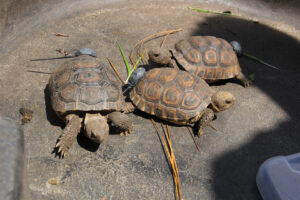
It took about two years for researchers to document the tortoises across the WMA. A 40-acre pen was constructed and tortoises from the 9,000-acre WMA were relocated there.
“We thought this was a cool project, but 100 tortoises is not where we wanted to be,” Goessling said. “We wanted to get more, if possible.”
The researchers then focused on females producing eggs, which are buried in the soft soil on the apron of the tortoise burrow. Eggs from six nests were collected the first year, followed by another 11 nests last year. The eggs went to Goessling’s lab at Eckerd College to hatch, and the young tortoises were then raised at both Goessling’s lab and the Birmingham Zoo.
The tortoises released at Geneva were 1-year-olds and 2-year-olds. Goessling said those tortoises exhibited a much faster growth rate than those of wild tortoises.
“Our biggest 2-year-old is about the size of a 10-year-old in the wild,” he said. “Our headstart tortoises, under captive conditions, have blown the growth rate out of the water for tortoises in the wild from either Alabama or Florida. Alabama tortoises for some unknown reason are really small as adults, and we are excited to see that their young were able to grow so fast.
“The work done by the state here has been great. We can raise tortoises in the lab, but at the end of the day, we can’t be tortoises for them. They need to be wild tortoises out here in open canopy, pine sand hills.”
Some of the young tortoises were released into a smaller pen, and the others were released on an adjacent site with no restrictions of movement.
Goessling said the next step will be monitoring the animals with radio transmitters affixed to one of the rear scutes (shell plates) on 90 tortoises, 30 of which are the animals head-started in captivity. Goessling said studies indicate that a population density of one female per acre is optimum because females are territorial.
“We can identify home range and spatial activity so that, when this pen goes down, we can find out if they’re staying here and are successful in building this core population,” he said. “Or, say, five years from now, we can find out if they are not maintaining fidelity. Long-term monitoring is the next step.”
Guyer applauded the recent efforts to enhance the gopher tortoise populations in Alabama.
“In my opinion, our state has taken a leading role in gopher tortoise conservation with interactions with the Fish and Wildlife Service and also the Gopher Tortoise Council,” Guyer said. “I’ve been studying gopher tortoises down here for the last 40 years, starting in the Conecuh National Forest and this new area down here. The data that are being used to make these life and death decisions about gopher tortoises, a bunch of it is coming from Alabama.
“Managing animals in Alabama is a lot different from the peninsula of Florida. Those studies in Conecuh indicate a smaller number of animals on a smaller land area, say 10 to 20 acres with 20 animals, can become stable or grow. But they have to be managed. We have to convince managers that if they’re doing prescribed fire on three-year intervals, they’re wasting their time. It has to be every two years.
“As long as we can maximize our efforts on these small areas with high intensity management, these smaller pockets are going to be viable. Most of this data is coming on the state level. Our hats should be doffed to the folks at the state level who have positioned us quite effectively in these leadership roles.”
WFF’s Ericha Nix, a non-game biologist who leads the gopher tortoise project team, said gopher tortoises have been petitioned for listing as threatened or endangered under USFWS guidelines.
“We looked at our lands to be proactive and create gopher tortoise populations,” Nix said. “We had surveys done on our public lands and found that some of our lands have 100 to 200 tortoises, but they don’t have the density needed to be viable.
“The Alabama Forestry Commission and its state forest next door does have a viable population of about 500 animals, but they have been managing for decades with prescribed fire. We found an area with suitable habitat with canopy and soils, which is how we got started with this project.”
Nix said WFF will continue to search for other sites to enhance the gopher tortoise habitat and possibly keep the animals off any imperiled lists.
“The more viable populations we create, the more we can prove to the Fish and Wildlife Service that we do have tortoises in viable populations, and we also take that regulatory burden off of private landowners,” she said. “We’re hoping we can show this as a demonstration area and show our industrial partners that they can take a 250-acre area and manage it for tortoises. We’re currently working with the (Alabama) Department of Corrections to assist in relocating tortoises from their project areas. We have developers reaching out to us with tortoises. It helps them and it helps us by building viable populations.
“For gopher tortoises, habitat loss continues to be our number one issue, either through development or the solar (panel) farms that are hitting us really hard right now. Every tortoise counts in Alabama. We do not have the animals that they do in Florida.”
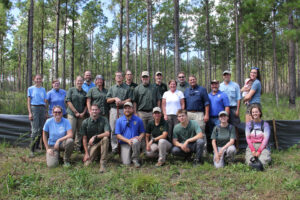
Silvano said gopher tortoises aren’t the only species to benefit from the intense management practices on the home range of the tortoises.
“One of the other benefits for this particular site is we manage it both for game and non-game species,” Silvano said. “This is a good example of how, when you manage the landscape for ecosystem function, it’s going to be beneficial for all critters, not just game. We want the public to know that when we manage the habitat, it benefits all species.”
Zach Hayes, a wildlife biologist aide at Geneva State Forest WMA, said after ADCNR purchased the property in 2014, intense work was done to improve the habitat through thinning the pines and performing prescribed fires.
“We had to open this place up extensively,” Hayes said. “We couldn’t plant our wildlife openings because of all the gopher tortoise burrows in those areas. We needed more open property for the tortoises to utilize, so we opened the canopy to get some light on the forest floor. With prescribed fire, we were able to reclaim our wildlife openings and plant food sources for the other wildlife to use.
“I love being a part of this. What’s good for gopher tortoises is good for turkey, quail and deer.”
David Rainer is an award-winning writer who has covered Alabama’s great outdoors for 25 years. The former outdoors editor at the Mobile Press-Register, he writes for Outdoor Alabama, the website of the Alabama Department of Conservation and Natural Resources.




